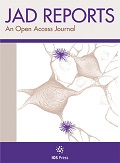Authors: Naeser, Margaret A. | Martin, Paula I. | Ho, Michael D. | Krengel, Maxine H. | Bogdanova, Yelena | Knight, Jeffrey A. | Hamblin, Michael R. | Fedoruk, Andrea E. | Poole, Luke G. | Cheng, ChiaHsin | Koo, BangBon
Article Type:
Research Article
Abstract:
Background: Chronic traumatic encephalopathy, diagnosed postmortem (hyperphosphorylated tau), is preceded by traumatic encephalopathy syndrome with worsening cognition and behavior/mood disturbances, over years. Transcranial photobiomodulation (tPBM) may promote improvements by increasing ATP in compromised/stressed cells and increasing local blood, lymphatic vessel vasodilation. Objective: Aim 1: Examine cognition, behavior/mood changes Post-tPBM. Aim 2: MRI changes - resting-state functional-connectivity MRI: salience, central executive, default mode networks (SN, CEN, DMN); magnetic resonance spectroscopy, cingulate cortex. Methods: Four ex-players with traumatic encephalopathy syndrome/possible chronic traumatic encephalopathy, playing 11– 16 years, received In-office, red/near-infrared tPBM to scalp, 3x/week for 6 weeks. Two
…had cavum septum pellucidum. Results: The three younger cases (ages 55, 57, 65) improved 2 SD (p < 0.05) on three to six neuropsychological tests/subtests at 1 week or 1 month Post-tPBM, compared to Pre-Treatment, while the older case (age 74) improved by 1.5 SD on three tests. There was significant improvement at 1 month on post-traumatic stress disorder (PTSD), depression, pain, and sleep. One case discontinued narcotic pain medications and had reduced tinnitus. The possible placebo effect is unknown. At 2 months Post-tPBM, two cases regressed. Then, home tPBM was applied to only cortical nodes, DMN (12 weeks); again, significant improvements were seen. Significant correlations for increased SN functional connectivity (FC) over time, with executive function, attention, PTSD, pain, and sleep; and CEN FC, with verbal learning/memory, depression. Increased n-acetyl-aspartate (NAA) (oxygen consumption, mitochondria) was present in anterior cingulate cortex (ACC), parallel to less pain and PTSD. Conclusion: After tPBM, these ex-football players improved. Significant correlations of increased SN FC and CEN FC with specific cognitive tests and behavior/mood ratings, plus increased NAA in ACC support beneficial effects from tPBM.
Show more
Keywords: Chronic traumatic encephalopathy, dementia, depression, neurodegenerative, pain, photobiomodulation, post-traumatic stress disorder, sleep, traumatic brain injury, traumatic encephalopathy
syndrome
DOI: 10.3233/ADR-220022
Citation: Journal of Alzheimer's Disease Reports,
vol. 7, no. 1, pp. 77-105, 2023





